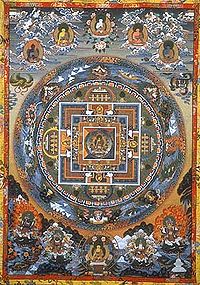Creating with Mandalas
Launch gallery slideshow

| Swap Coordinator: | LadyT (contact) |
| Swap categories: | Art |
| Number of people in swap: | 16 |
| Location: | International |
| Type: | None |
| Last day to signup/drop: | January 21, 2009 |
| Date items must be sent by: | February 4, 2009 |
| Number of swap partners: | 1 |
| Description: | |
|
THIS IS AN INTERNATIONAL SWAP WITH ONE (1) PARTNER. You will print-off a FREE mandala at: www.mandalaproject.org You will color it via whatever medium you prefer or choose . . .crayons, markers, pastels, water paints, etc. Upon signing up, you will receive a journaling exercise to complete when coloring your mandala. You will send your finished mandala (or a color copy of) and your journaling work to your partner by the send date. RULES (even though I hate them) Rating of 4.5 or better, with NO no sends in the past six months. Go ahead and message me if you’ve been rated unfairly at any point or have a good reason for your lower rating or the no sends, and we’ll talk. I’m certainly open to listening - as I understand LIFE HAPPENS! Newbies allowed, but with filled out profiles please by the time you are signing up. Communication is key. If you’re going to be late with the swap, let your partner know. If your partner tells you he/she is going to be late, and keeps up the communication, give him/her a break. Sometimes things come up that just can’t be helped. Life happens! I reserve the right to ban anyone that I think might be a problem. This means people that I've noticed have a history of rating unfairly, nastiness, etc. I believe in playing nice & fairly. ENJOY, Have FUN - after-all, this is a HOBBY . . hobbies are supposed to bring you joy & happiness!!!!!!!! The Pattern of Creation The word "Mandala" is from the classical Indian language of Sanskrit. Loosely translated to mean "circle," a Mandala is far more than a simple shape. It represents wholeness, and can be seen as a model for the organizational structure of life itself--a cosmic diagram that reminds us of our relation to the infinite, the world that extends both beyond and within our bodies and minds. Describing both material and non-material realities, the Mandala appears in all aspects of life: the celestial circles we call earth, sun, and moon, as well as conceptual circles of friends, family, and community. "The integrated view of the world represented by the Mandala, while long embraced by some Eastern religions, has now begun to emerge in Western religious and secular cultures. Awareness of the Mandala may have the potential of changing how we see ourselves, our planet, and perhaps even our own life purpose." (From Mandala: Journey to the Center, by Bailey Cunningham) More than a Pretty Picture . . . . . Representing the universe itself, a Mandala is both the microcosm and the macrocosm, and we are all part of its intricate design. The Mandala is more than an image seen with our eyes; it is an actual moment in time. It can be can be used as a vehicle to explore art, science, religion and life itself. The Mandala contains an encyclopedia of the finite and a road map to infinity. Carl Jung said that a Mandala symbolizes "a safe refuge of inner reconciliation and wholeness." It is "a synthesis of distinctive elements in a unified scheme representing the basic nature of existence." Jung used the Mandala for his own personal growth and wrote about his experiences. It is said by Tibetan Buddhists that a Mandala consists of five "excellencies": The teacher • The message • The audience • The site • The time An audience or "viewer" is necessary to create a Mandala. Where there is no you, there is no Mandala. (from: You Are the Eyes of the World, by Longchenpa, translated by Lipman and Peterson). The Mandala in Nature . . . . The "circle with a center" pattern is the basic structure of creation that is reflected from the micro to the macro in the world as we know it. It is a pattern found in nature and is seen in biology, geology, chemistry, physics and astronomy. On our planet, living things are made of cells and each cell has a nucleus -- all display circles with centers. The crystals that form ice, rocks, and mountains are made of atoms. Each atom is a Mandala. Within the Milky Way galaxy is our solar system and within our solar system, is Earth. Each is a Mandala that is part of a larger Mandala. Flowers, the rings found in tree trunks and the spiraling outward and inward of a snail's shell all reflect the primal Mandala pattern. Wherever a center is found radiating outward and inward, there is wholeness--a Mandala. The Mandala in Art & Culture . . . . The Mandala pattern is used in many religious traditions. Hildegard von Bingen, a Christian nun in the 12th century, created many beautiful Mandalas to express her visions and beliefs. In the Americas, Indians have created medicine wheels and sand Mandalas. The circular Aztec calendar was both a timekeeping device and a religious expression of ancient Aztecs. In Asia, the Taoist "yin-yang" symbol represents opposition as well as interdependence. Tibetan Mandalas are often highly intricate illustrations of religious significance that are used for meditation. Mandalas in Architecture . . . . From Buddhist stupas to Muslim mosques and Christian cathedrals, the principle of a structure built around a center is a common theme in architecture. Native American teepees are conical shapes built around a pole that represents the "axis mundi" or world axis. Buckminster Fuller expanded on the dome design with his famous geodesic dome structures. The dome structure has the highest ratio of enclosed area to external surface area, and all structural members contribute equally to the whole--a great structural representation of a Mandala! Experiencing the Transformational Power of the Mandala Mandalas are the visual expression of divine connection. Through their swirl of color and intention we can reach new levels of consciousness. Experience and use these Mandalas as tools for meditation, connection, and resolution. | |
Discussion
Leave a Comment
You must be logged in to leave a comment. Click here to log in.
- Info:
- Home
- |
- About
- |
- Forum Rules
- |
- Terms of Use
- |
- Press
- |
- Advertising
- |
- Blog
- |
- Graphics & Stuff
- Help:
- New User Info
- |
- FAQ
- |
- Group Info
- |
- Glossary
- |
- Forums
- |
- |
- Contact Admin

